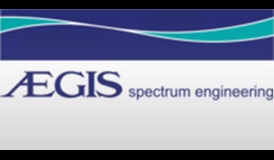 Aegis Systems Limited, a spectrum engineering consultancy founded in 1988, studies the behavior of the radio spectrum: the way that radio waves act and interact. Following a trial run of several software packages, Aegis chose to use Mathsoft's calculation management software Mathcad (now PTC Mathcad) in conjunction with both Fortran and C++ as a company-wide tool. PTC Mathcad was tested against competitors such as Maplesoft (Maple) and Wolfram Research (Mathematica) and was chosen by Aegis due to its intuitive and user-friendly interface.
Aegis Systems Limited, a spectrum engineering consultancy founded in 1988, studies the behavior of the radio spectrum: the way that radio waves act and interact. Following a trial run of several software packages, Aegis chose to use Mathsoft's calculation management software Mathcad (now PTC Mathcad) in conjunction with both Fortran and C++ as a company-wide tool. PTC Mathcad was tested against competitors such as Maplesoft (Maple) and Wolfram Research (Mathematica) and was chosen by Aegis due to its intuitive and user-friendly interface.
PTC Mathcad is often used for simulation projects by Aegis in instances when there is a fast calculation required that would take too long to perform in a programming language. Aegis currently employs six engineers, and fee income is fairly evenly divided between public- and private-sector work. For example, engineers carried out a project to discover how two satellites in different orbits would intersect and interact. They wrote a simulation using PTC Mathcad that would run over two days.
Aegis keeps a reference library of PTC Mathcad worksheets from each project it undertakes. This careful calculation management means that junior engineers can access a wealth of accumulated information for reference and senior engineers spend less time explaining fundamental calculations. Another benefit of keeping such records is that if a colleague leaves, his or her knowledge can be preserved, to the advantage of the company.
Richard Rudd, a principal consulting engineer at Aegis, said: "PTC Mathcad has set a standard for the way in which we work, helping us to manage our time more effectively, which has had an impact on the productivity of the business as a whole."
The British National Space Center (BNSC) S@TCOM scheme has been running for three years, and projects and studies within the scheme have been undertaken by subject matter experts (SMEs) such as Aegis as well as by large organizations such as Roke Manor Research and Astrium. S@TCOM was developed to help UK companies develop expertise and knowledge in the satellite market.
In early September 2003, Aegis was tasked with producing statistics that measure the effect of the built environment on wideband radio signals to aid the S@TCOM scheme.
For this purpose it used a helium balloon to simulate satellite paths at several built-up locations around the southeast of England. Results were fed into PTC Mathcad and three-dimensional representations of the radio channel response were produced.
The results of the study are of particular interest to the UK space industry, part of which is about to become involved in the European version of the United States' Global Positioning System (GPS). This is because Aegis' study was designed to measure how buildings would affect the strength of each radio wave, which is fundamental to positioning technologies, as well as other technologies such as cellular telephones and radar.
"Due to the speed at which PTC Mathcad can process data and present it visually, we were able to present the figures pertaining to the experiments to the BNSC within just two days," commented Rudd.
British companies that wish to take advantage of the commercial benefits of satellite will use Aegis' results ― including markets such as telecoms, broadcast, earth observation and navigation that need to know how conurbations will affect them and their technology.
In order to measure the way in which buildings would change the radio signals, Aegis' engineers had to simulate the possible variations in elevation angle of satellites, while transmitting and receiving radio signals. Initially, a helicopter was sought for the simulation; however, this method turned out to be unsuitable because of budgetary and environmental constraints.
Eventually the team decided to use a large helium-filled balloon as an alternative. A transmitter was attached to the balloon, and a receiver was positioned at different locations inside each building.
Radio channel responses were collected at approximately one per second for 100 seconds. The receiver forwarded the results directly to a laptop and the raw data was collected. The data was then fed into PTC Mathcad, and two- and three-dimensional charts demonstrating the various channel responses were created.
A pattern developed which showed that instead of the single uniform peak, which would be expected in a "perfect" channel, the direct signal from the simulated satellite was followed by multiple smaller signals of decreasing amplitude.
This pattern demonstrates that the buildings, terrain and other clutter interfere with the radio channel by giving rise to delayed reflections, as expected. Aegis also was able to assess the size of the delay in various locations and draw conclusions accordingly. The research also revealed that, for the locations examined, the radio channel statistics showed no dependence on the elevation of the "satellite."
Established in 1988, Aegis Systems Limited provides a complete range of spectrum engineering and frequency management services based on comprehensive knowledge of the theory and practice of radio system engineering. Aegis is now recognized as one of Europe's leading providers of consultancy in the field, offering detailed knowledge of regulatory matters together with practical expertise in interference analysis and propagation modeling. This core capability is supported and enhanced by its expertise in the development of custom software. With wide experience in spectrum engineering, Aegis offers its clients fast, accurate and pragmatic solutions to practical and theoretical problems in spectrum engineering.
Like Aegis, you too can leverage the speed and productivity benefits of PTC Mathcad Prime. Try out the latest version of Mathcad Prime for yourself and compare to how you're currently doing engineering calculations.